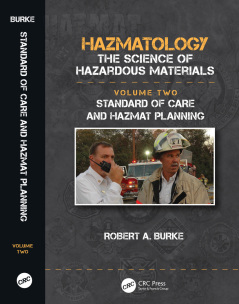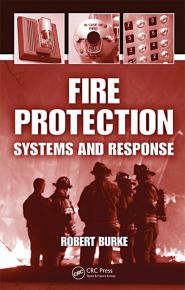Books Written by Robert Burke
<< New text box
Hazmatology: The Science of Hazardous Materials, Five-Volume Set
This five volume set Hazmatology is a new discipline dealing with the most common aspects of hazardous materials, containers, and the affected environment. It focuses on innovations in decontamination, monitoring instruments, personal protective equipment, and takes a risk-benefit approach to hazardous material response.
Hazmatology: Chronicles of Hazardous Materials Incidents and Response (Volume One)
This book takes an in-depth look at the history of hazardous materials response, while pointing out the lessons learned and discussing the impact on our response today. The book aims to be the most comprehensive study of hazardous materials history ever presented in a single volume.
FEATURES
- Uses a scientific approach utilizing analysis of previous incidents
- Offers a risk-benefit approach based upon science and history
- Provides an exploration of current research
- Simplifies physical and chemical characteristics
- Converts hazmat studies to an in-depth course of study
Hazmatology: Hazardous Materials Standard of Care (Volume Two)
Emergency responders are bound to a Standard of Care for response to hazardous materials incidents. It is based on Federal Law, Regulations, and consensus standards. This book presents the Hazardous Materials legal issues and background on the Hazmat Standard of Care, and includes incidents where Care was violated, and the repercussions felt.
FEATURES
- Uses a scientific approach utilizing analysis of previous incidents
- Offers a risk-benefit approach based upon science and history
- Provides an exploration of current research
- Outlines the elements of Standard of Care response
- Includes case studies and in-depth history of Standard of Care response
Hazmatology: Applied Chemistry and Physics (Volume Three)
Dealing with hazardous materials incidents cannot be accomplished without knowing the effects of these materials. This book is not about teaching chemistry and physics. It is about presenting chemistry and physics at the level that emergency responders will understand so they can apply the concepts using a risk management system.
FEATURES
- Uses a scientific approach utilizing analysis of previous incidents
- Offers a risk-benefit approach based upon science and history
- Provides understanding tools for your Hazmat Tool Box
- Simplifies physical and chemical characteristics
Hazmatology: Common Sense Emergency Response (Volume Four)
Options for stabilization can vary widely depending on the scope and size of the incident and hazards involved. This book covers this process and includes science and risk analysis and the part it plays in a successful outcome of the stabilization portion of the response.
FEATURES
- Offers a risk-benefit approach based upon science and history
- Provides an exploration of current research
- Outlines a systematic approach based on science and risk management
- Includes hazmat case studies
Hazmatology: Hazmat Team Spotlight (Volume Five)
This book covers hazardous materials teams across the United States. Teams differ, but basic procedures are similar. Levels of response vary between urban or rural areas. Resources also vary between locations. This book covers the history, vehicles, types of response, equipment and resources, procedures and innovations across different teams.
FEATURES
- Uses a scientific approach utilizing analysis of previous incidents
- Offers a risk-benefit approach based upon science and history
- Provides an exploration of current research and case studies nation wide
- Outlines the basic operation procedures
Purchase from CRC Press, Barnes & Noble and Amazon.
https://www.crcpress.com/
Using the authors many years of experience in emergency services and his skills as a hazardous materials consultant, prepares the first responder to handle everything from re-establishing control and on-scene triage to investigating the crime. Including information on pre-incident and avoidance tactics, the author also discusses monitoring and detection techniques, protective equipment and decontamination, and an extensive list of resource organizations and training opportunities. This up-to-date 3rd edition is written to provide concise information for emergency responders who might be called upon to confront Armed Shooters, explosive, chemical, nuclear, biological, or incendiary acts of terrorism.
Features
- Explains the idea of a close relationship between hazardous materials and terrorism.
- Covers in detail terrorist agents and devices.
- Identifies terrorists who were captured and the results of their trials.
- Expanded tactical consideration for terrorist responses.
- Comprehensivve listings of terror incidents around the world as wll as those in the United States.
- Outlines changes in emergency response tactics since the 9/11 attacks.
- Provides the latest information on terrorist agents including bacterial, viral, blister-, blood-, nerve-toxins, irritants, and “dirty bombs”.
- Details specific procedures for hazardous material identification and containment, and for emergency treatment.
- Examines new techniques and devices for monitoring and detection, protective equipment, and decontamination.
- Offers an updated list of training programs and courses.
- New Chapter; Foiled Terrorist Plots.
- New Chapter; Evolution of Terrorism and Terrorist Groups.
- New Chapter; Active Shooter.
- New ChapterFuture of Terrorism.
Summary
Terrorism is no longer something that only happens to other countries. Attacks on US soil in the 1990’s brought the reality of terrorism home and the Sept 11th tragedy let us know that the United States is a high priority target. The goal of today’s terrorist is body count, and while traditional bombings have served them in the past, the allure of killing thousands of people with a very small amount of biological or chemical agent will prove irresistible. Our only defense on the front line is a well-prepared emergency response team.
The key to an effective terrorist response is to understand and contain the hazardous materials involved. Counter-Terrorism for Emergency Responders, Second Edition meticulously details the characteristics, actions, identification, containment, and emergency treatment of all types of agents. Drastically updated from the 1999 edition, chapter after chapter is packed with new information on chemical agents, biological agents, and explosive, nuclear, and incendiary devices.
Using his 26 years of experience in emergency services and his skills as a hazardous materials consultant in more than 15 states, the author prepares the first responder to handle everything from re-establishing control and on-scene triage to investigating the crime. Including information on pre-incident and avoidance tactics, the author provides new monitoring and detection techniques, protective equipment and decontamination, and an extensive list of resource organizations and training opportunities. The worst may never happen to your community, but will you be prepared if it does?
Purchase from CRC Press, Barnes & Noble and Amazon.com.
https://www.crcpress.com/search/results?kw=Counter+Terrorism+for+Emergency+Responders
HazMat Teams Across America contains the history of selected hazardous materials incidents over the past 100 years and features 30 different HazMat Teams from departments across the United States. Information on equipment innovations are also included. The HazMat teams that are featured in the book are: Allegheny County, PA; Anchorage, Alaska; Anne Arundel County, MD; Anniston, AL; Burlington, NJ; Charles County, MD; Cheyenne, WY; Chicago, IL; Denver, CO; Honolulu, HI; Houston, TX; Jacksonville, FL; Kansas City, MO; Lake County, IN; Lincoln, NE; Louisville, KY; Nashville, TN; New Orleans, LA; Nutley, NJ; Orlando, FL; Omaha, NE; Philadelphia, PA; Picatinny Arsenal, NJ; Reno, NV; San Diego, CA; Seattle, WA; St. Louis County, MO; Yonkers, NY; Yuma, AZ and Sacramento, CA. 192 pages.
Purchase from Publisher:
http://mtpublishing.com/index.php/default/hazmat-group.html
Features
- Provides an overview of hazardous materials chemistry organized into a known chemical hazard system developed by the United Nations and the United States Dept. of Transportation
- Includes all-new review questions with answers included in the book
- Presents information on Ethanol and other alternative automotive fuels
- Shows new incident examples
Summary
The third edition of a bestseller, Hazardous Materials Chemistry for Emergency Responders continues to provide the fundamentals of "street chemistry" required by emergency response personnel. Emergency response and hazmat expert Robert Burke takes the basics of chemistry appropriate for response personnel and puts it into understandable terms. The author has retained the style and format that made the previous editions so popular while updating the information to keep the book relevant.
See What’s in the Third Edition:
- Expanded section on Ethanol and its hazards to responders
- Update of NFPA 472 Chemistry requirements
- Revised section on "hazmat elements" with more hazards and response issues
- Includes a focus on the importance of the "hazmat elements" of chemical families
- New incident examples
- New photographs and graphics
The chapters are organized by the nine U.S. Department of Transportation's hazard classes. Almost every hazardous material presents more than one hazard; the DOT’s placarding and labeling system only identifies the most severe hazards. Therefore, the book provides additional information about hidden hazards for each hazard class. It discusses individual chemicals, their hazards and their physical and chemical characteristics, both as distinct chemicals and within chemical families.
The book offers a concise presentation of the topics of most importance to emergency responders on a day-to-day basis. It provides the basic chemistry a responder needs to understand chemical terminology and communicate with others about the chemicals involved in hazardous materials incidents.
Purchase from CRC Press, Barnes & Noble and Amazon.com.
https://www.crcpress.com/Hazardous-Materials-Chemistry-for-Emergency-Responders-Third-Edition/Burke/p/book/9781138074651
Features
- Provides critical safety information of practical use to first responders for a wide variety of building systems
- Includes over 250 photographs and tables to reinforce the discussion with visual examples
- Examines the features of elevators that may assist first responders during fires and other events
- Reviews the aspects of building service equipment that can hinder and aid the efforts of firefighters
- Introduces the dangers posed to emergency personnel by powerful magnets in equipment such as MNR and MRI machines
- Offers an overview of the common workings of fire alarm and suppression systems
Summary
The modern definition of firefighter no longer means “putting the wet stuff on the red stuff.” Emergency responders answer incidents ranging from fire alarm activations to elevator rescues and medical emergencies more often than full-blown fires. Consequently, responders increasingly interface with a wide array of building systems. Underscoring the changing role of firefighters, Fire Protection: Systems and Response presents the basic knowledge of the inner workings of fire safety/fire protection systems and related equipment in buildings.
The author provides a straightforward overview of the functions and benefits of these systems and how they can assist with fire suppression, code enforcement, alarm response, and elevator rescue. The book’s comprehensive discussion of elevators, fire command centers, emergency generators and lighting, and HVAC systems sets it apart from other fire protection books currently available. The topics covered prepare emergency response personnel for the challenges they face working with fire protection systems, fire alarm systems, and elevators.
Logically organized, clearly written, and covering all systems in a single text, this presentation of information streamlines fire service interaction with building
features and fire protection systems. Providing an understanding of how systems are designed and installed, the book is also a reference for troubleshooting fire protection problems in the field. The
information not only gives responders an appreciationknowledge of how the systems work, but helps them use this knowledge to perform their job
better.
Purchase from CRC Press, Barnes & Noble and Amazon.com.
https://www.crcpress.com/Fire-Protection-Systems-and-Response/Burke/p/book/9781566706223











